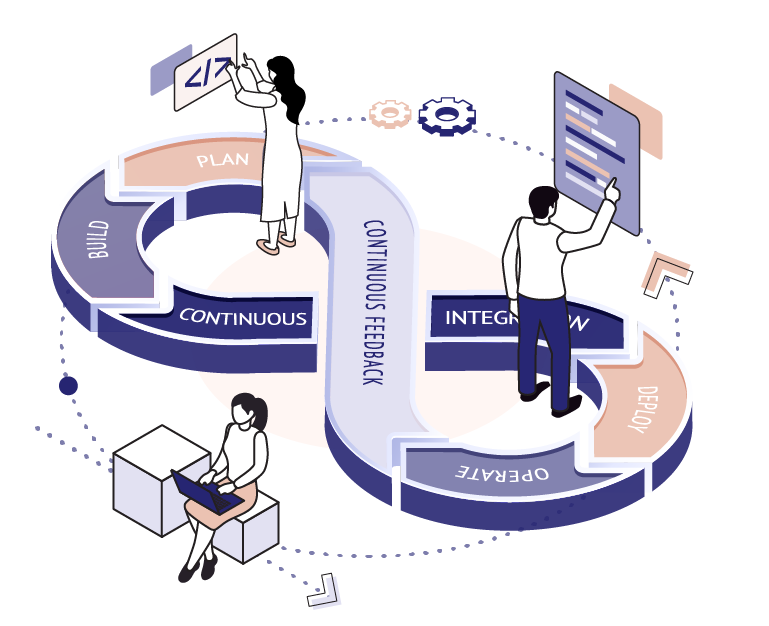A viewpoint by Seif Kardous, consultant at Amaris Consulting.
What is an agile methodology?
Agile methodology is a mindset and a project management process, mainly used in the software industry.
It is based on the values of adaptability and flexibility and allows teams to be more organized and cross-functional. The agile methodology involves continuous collaboration with the client in defining their business needs to create valuable and workable outcomes.
Software development: what’s the difference between a traditional and agile organization?
Traditional development methodology
Traditional software development methodologies are based on pre-defined and organized steps, in addition to requirements of the development lifecycle. Here, the development process is unidirectional, from requirements definition, analysis, architecture conception, detailed conception, and development, to testing, validation and maintenance (V Cycle).
In this type of traditional model, each phase has specific deliverables and documentation that have passed an in-depth evaluation process but do not involve client participation:
- Business requirements are defined completely before the start of the project. The end solution also needs to be defined in advance and cannot be modified once the project starts.
- To make sure that the development is aligned with end product expectations and business requirements, the client cannot incorporate modifications or evaluations during the development of the project.
- The client will be delivered a product based on the developer’s understanding of the requirements at the start of the project. The possibilities of satisfying customer needs at this stage are very low.
- The testing phase starts after the development phase. Once the application is in the testing stage, it is not possible to go back and edit anything that has already been developed, as this would mean having to start the cycle over again.
With the application of these traditional methodologies, there is a high risk of developing a product that does not meet the exact client requirements and expectations. This is due to the lack of input from the customers during the development phases of the project.
Agile software development methodology
Unlike traditional approaches, the agile methodology is more precise and involves clients throughout the process. Clients can participate in any phase of project development to align and modify the product to meet their expectations and business requirements.
Here are some advantages of agile methodologies over traditional ones:
- Even though business requirements and project roadmaps are defined in advance, they can be aligned, improved, and modified at any time.
- There is no need to refine all requirements before starting the project.
- The solution can be divided into increments delivered periodically, which allows clients to have a clear idea of the advancement of the project, and orient the project needs in the right direction.
- The client has the chance to evaluate solution increments with every delivery and check if the level of quality and value matches their expectations.
- Testing is done at the same time as the development, allowing the cost of modifications to be reduced.
In summary, the agile methodology is based on a gradual and iterative approach. This process involves the client in most steps of project development, which minimizes the risk of having an end solution that does not match the client business requirements and expectations, ensuring a high-value end product.
The roadmap to agile transformation
Software development teams cannot become agile overnight; it’s a transformation process that requires time and effort. A company should start its journey towards becoming agile by identifying areas for improvement in process management, with the goal of reaching a stable agile environment.
An agile expert will help to define a company’s transformation roadmap by promoting this new mindset and helping the team to adapt to a new way of working, while also improving their organizational skills.
Every team member should understand their role within an agile team. They should adopt agile values and be proactive in order to become a cross-functional and self-organized team.
It is important to introduce the agile practice within the team slowly and incrementally. First, define the most essential and easy to implement agile values, and secondly, implement them gradually to avoid slowing down the development of ongoing projects.
It is also recommended to implement training sessions involving stakeholders and the development team. Training sessions will ensure the progress of the agile methodology for all concerned parties of the project, making the communication between the team and stakeholders much easier and more transparent.
The agile expert is in charge of coaching the team, following up their process implementing progress until they reach a significant level of self-organization and cross-functionality, while adapting the agile mindset and methodology by themselves.
In conclusion, agile methodologies can be summarized as a mindset or way of thinking. We can use agile methodologies throughout different scenarios in software development projects and professional environments, such as when interacting with people and project management. The agile concept regroups a certain number of values, such as transparency, flexibility, optimization of human interactions, and collaboration improvement; working as a team towards a common goal always generates more significant results, and this is the promise of agile methodologies.
You wish to learn more about our capabilities? Discover our Software and development knowledge.


